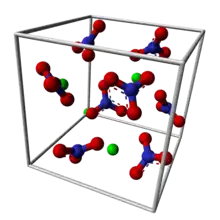Strontium nitrate
Strontium nitrate is an inorganic compound composed of the elements strontium, nitrogen and oxygen with the formula Sr(NO3)2. This colorless solid is used as a red colorant and oxidizer in pyrotechnics.
 | |
 | |
| Names | |
|---|---|
| IUPAC name
Strontium nitrate | |
| Identifiers | |
3D model (JSmol) |
|
| ChemSpider | |
| ECHA InfoCard | 100.030.107 |
| EC Number |
|
PubChem CID |
|
| UNII | |
CompTox Dashboard (EPA) |
|
| |
| |
| Properties | |
| Sr(NO3)2 | |
| Molar mass | 211.630 g/mol (anhydrous) 283.69 g/mol (tetrahydrate) |
| Appearance | white crystalline solid |
| Density | 2.986 g/cm3 (anhydrous) 2.20 g/cm3 (tetrahydrate)[1] |
| Melting point | 570 °C (1,058 °F; 843 K) (anhydrous) 100 °C, decomposes (tetrahydrate) |
| Boiling point | 645 °C (1,193 °F; 918 K) decomposes |
| anhydrous: 710 g/L (18 °C) 660 g/L (20 °C) tetrahydrate: 604.3 g/L (0 °C) 2065 g/L (100 °C) | |
| Solubility | soluble in ammonia very slightly soluble in ethanol, acetone insoluble in nitric acid |
| −57.2·10−6 cm3/mol | |
| Structure | |
| cubic (anhydrous) monoclinic (tetrahydrate) | |
| Hazards | |
| Occupational safety and health (OHS/OSH): | |
Main hazards |
Irritant |
| NFPA 704 (fire diamond) | |
| Flash point | Non-flammable |
| Lethal dose or concentration (LD, LC): | |
LD50 (median dose) |
2750 mg/kg (rat, oral) |
| Safety data sheet (SDS) | |
| Related compounds | |
Other anions |
Strontium sulfate Strontium chloride |
Other cations |
Beryllium nitrate Magnesium nitrate Calcium nitrate Barium nitrate |
Except where otherwise noted, data are given for materials in their standard state (at 25 °C [77 °F], 100 kPa).
Infobox references | |
Preparation
Strontium nitrate is typically generated by the reaction of nitric acid on strontium carbonate.[2]

Uses
Like many other strontium salts, strontium nitrate is used to produce a rich red flame in fireworks and road flares. The oxidizing properties of this salt are advantageous in such applications.[3]
Strontium nitrate can aid in eliminating and lessening skin irritations. When mixed with glycolic acid, strontium nitrate reduces the sensation of skin irritation significantly better than using glycolic acid alone.[4]
Biochemistry
As a divalent ion with an ionic radius similar to that of Ca2+ (1.13 Å and 0.99 Å respectively), Sr2+ ions resembles calcium's ability to traverse calcium-selective ion channels and trigger neurotransmitter release from nerve endings. It is thus used in electrophysiology experiments.
In popular culture
In his short story "A Germ-Destroyer", Rudyard Kipling refers to strontium nitrate as the main ingredient of the titular fumigant.
References
- Patnaik, Pradyot (2002). Handbook of Inorganic Chemicals. McGraw-Hill, ISBN 0-07-049439-8
- Ward, R.; Osterheld, R. K.; Rosenstein, R. D. (1950). Strontium Sulfide and Selenide Phosphors. Inorganic Syntheses. Vol. 3. pp. 11–23. doi:10.1002/9780470132340.ch4. ISBN 978-0-470-13234-0.
- MacMillan, J. Paul; Park, Jai Won; Gerstenberg, Rolf; Wagner, Heinz; Köhler, Karl and Wallbrecht, Peter (2002) "Strontium and Strontium Compounds" in Ullmann's Encyclopedia of Industrial Chemistry, Wiley-VCH, Weinheim. doi:10.1002/14356007.a25_321
- Zhai H, Hannon W, Hahn GS, Pelosi A, Harper RA, Maibach HI (2000). "Strontium nitrate suppresses chemically-induced sensory irritation in humans". Contact Dermatitis. 42 (2): 98–100. doi:10.1034/j.1600-0536.2000.042002098.x. PMID 10703633. S2CID 25910851.
